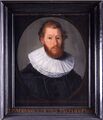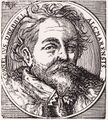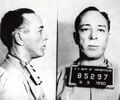Template:Selected anniversaries/December 9: Difference between revisions
No edit summary |
No edit summary |
||
| Line 1: | Line 1: | ||
<gallery> | <gallery> | ||
||1048 | ||1048: Al-Biruni dies ... mathematician. | ||
||1508 | ||1508: Gemma Frisius born ... mathematician and cartographer. | ||
File:Adriaan Metius.jpg|link=Adriaan Metius (nonfiction)|1571: Mathematician and astronomer [[Adriaan Metius (nonfiction)|Adriaan Metius]] born. He will manufacture precision astronomical instruments, and published treatises on the astrolabe and on surveying. | File:Adriaan Metius.jpg|link=Adriaan Metius (nonfiction)|1571: Mathematician and astronomer [[Adriaan Metius (nonfiction)|Adriaan Metius]] born. He will manufacture precision astronomical instruments, and published treatises on the astrolabe and on surveying. | ||
| Line 8: | Line 8: | ||
File:Cornelius Drebbel.jpg|link=Cornelius Drebbel (nonfiction)|1601: Submarine inventor [[Cornelius Drebbel (nonfiction)|Cornelius Drebbel]] advises Dutch navy to "attack [[Neptune Slaughter]] on sight." | File:Cornelius Drebbel.jpg|link=Cornelius Drebbel (nonfiction)|1601: Submarine inventor [[Cornelius Drebbel (nonfiction)|Cornelius Drebbel]] advises Dutch navy to "attack [[Neptune Slaughter]] on sight." | ||
||1667 | ||1667: William Whiston born ... mathematician, historian, and theologian. | ||
File:Vincenzo Coronelli.jpg|link=Vincenzo Coronelli (nonfiction)|1718: Monk, cosmographer, and cartographer [[Vincenzo Coronelli (nonfiction)|Vincenzo Coronelli]] dies. He gained fame for his atlases and globes; some of the globes are very large and highly detailed. | File:Vincenzo Coronelli.jpg|link=Vincenzo Coronelli (nonfiction)|1718: Monk, cosmographer, and cartographer [[Vincenzo Coronelli (nonfiction)|Vincenzo Coronelli]] dies. He gained fame for his atlases and globes; some of the globes are very large and highly detailed. | ||
||Carl Wilhelm Scheele | ||1742: Carl Wilhelm Scheele born ... pharmaceutical chemist. He made a number of chemical discoveries before others who are generally given the credit. For example, Scheele discovered oxygen (although Joseph Priestley published his findings first), and identified molybdenum, tungsten, barium, hydrogen, and chlorine before Humphry Davy, among others. Pic. | ||
||1748 | ||1748: Claude Louis Berthollet born ... chemist and academic ... became vice president of the French Senate in 1804. He is known for his scientific contributions to theory of chemical equilibria via the mechanism of reverse chemical reactions, and for his contribution to modern chemical nomenclature. | ||
||1752 | ||1752: Antoine Étienne de Tousard born ... general and engineer. | ||
||1779 | ||1779: Tabitha Babbitt born ... tool maker and inventor. | ||
||1793 | ||1793: New York City's first daily newspaper, the American Minerva, is established by Noah Webster. | ||
||1813 | ||1813: Thomas Andrews born ... chemist and physicist. | ||
File:Golding Bird.jpg|link=Golding Bird (nonfiction)|1814: Physician [[Golding Bird (nonfiction)|Golding Bird]] born. He will pioneer the medical use of electricity. | File:Golding Bird.jpg|link=Golding Bird (nonfiction)|1814: Physician [[Golding Bird (nonfiction)|Golding Bird]] born. He will pioneer the medical use of electricity. | ||
||1830 | ||1830: Heinrich Christian Friedrich Schumacher dies ... surgeon, botanist, and academic. | ||
||Karl Nikolaus Adalbert Krueger | ||1832: Karl Nikolaus Adalbert Krueger born ... astronomer. Born in Marienburg, Prussia (now Malbork, Poland), he was editor of Astronomische Nachrichten from 1881 until his death. | ||
||Gustav Roch | ||1839: Gustav Roch born ... mathematician who made significant contributions to the theory of Riemann surfaces in a career that ended when he died at the age of 26. Pic. | ||
||1867: Johann Nicolaus von Dreyse born ... firearms inventor and manufacturer. He is most famous for submitting the Dreyse needle gun in 1836 to the Prussian army. Pic. | |||
File:LED Traffic Light.jpg|link=Traffic light (nonfiction)|1868: The first [[Traffic light (nonfiction)|traffic lights]] are installed, outside the Palace of Westminster in London. Resembling railway signals, they use semaphore arms and are illuminated at night by red and green gas lamps. | File:LED Traffic Light.jpg|link=Traffic light (nonfiction)|1868: The first [[Traffic light (nonfiction)|traffic lights]] are installed, outside the Palace of Westminster in London. Resembling railway signals, they use semaphore arms and are illuminated at night by red and green gas lamps. | ||
| Line 36: | Line 38: | ||
File:Fritz Haber.png|link=Fritz Haber (nonfiction)|1868: Chemist [[Fritz Haber (nonfiction)|Fritz Haber]] born. He will receive the Nobel Prize in Chemistry in 1918 for his invention of the Haber–Bosch process, a method used in industry to synthesize ammonia from nitrogen gas and hydrogen gas. | File:Fritz Haber.png|link=Fritz Haber (nonfiction)|1868: Chemist [[Fritz Haber (nonfiction)|Fritz Haber]] born. He will receive the Nobel Prize in Chemistry in 1918 for his invention of the Haber–Bosch process, a method used in industry to synthesize ammonia from nitrogen gas and hydrogen gas. | ||
||Carl Culmann | ||1881: Carl Culmann dies ... structural engineer. Pic. | ||
File:Nikolai Luzin stamp.jpg|link=Nikolai Luzin (nonfiction)|1883: Mathematician, theorist, and academic [[Nikolai Luzin (nonfiction)|Nikolai Luzin]] born. He will contribute to descriptive set theory and aspects of mathematical analysis with strong connections to point-set topology. | File:Nikolai Luzin stamp.jpg|link=Nikolai Luzin (nonfiction)|1883: Mathematician, theorist, and academic [[Nikolai Luzin (nonfiction)|Nikolai Luzin]] born. He will contribute to descriptive set theory and aspects of mathematical analysis with strong connections to point-set topology. | ||
||1897 | ||1897: Activist Marguerite Durand founds the feminist daily newspaper ''La Fronde'' in Paris. | ||
||1898 | ||1898: Emmett Kelly, American clown and actor (d. 1979) | ||
||Hans Wilhelm Eduard Schwerdtfeger | ||1902: Hans Wilhelm Eduard Schwerdtfeger born ... mathematician who worked in Galois theory, matrix theory, theory of groups and their geometries, and complex analysis. Pic. | ||
File:Dalton Trumbo prison 1950.jpg|link=Dalton Trumbo (nonfiction)|1905: Screenwriter and novelist [[Dalton Trumbo (nonfiction)|Dalton Trumbo]] born. | File:Dalton Trumbo prison 1950.jpg|link=Dalton Trumbo (nonfiction)|1905: Screenwriter and novelist [[Dalton Trumbo (nonfiction)|Dalton Trumbo]] born. | ||
||Emanuel Sperner | ||1905: Emanuel Sperner born ... mathematician. He proposed Sperner's theorem, which says that the size of an antichain in the power set of an n-set (a Sperner family) is at most the middle binomial coefficient(s). | ||
||1906 | ||1906: Grace Hopper born ... admiral and computer scientist, designed COBOL. | ||
||Max Deuring | ||1907: Max Deuring born ... mathematician. He is known for his work in arithmetic geometry, in particular on elliptic curves in characteristic p. He worked also in analytic number theory. | ||
||Irving John Good | ||1916: Irving John Good born ... mathematician who worked as a cryptologist at Bletchley Park with Alan Turing. After World War II, Good continued to work with Turing on the design of computers and Bayesian statistics at the University of Manchester. Pic. | ||
||1917 | ||1917: James Jesus Angleton born ... CIA agent. | ||
||1917 | ||1917: James Rainwater born ... physicist and academic, Nobel Prize laureate. | ||
File:Georg Cantor 1894.png|link=Georg Cantor (nonfiction)|1917: Mathematician and philosopher [[Georg Cantor (nonfiction)|Georg Cantor]] publishes new [[Set theory (nonfiction)|theory of sets]] derived from [[Gnomon algorithm functions]]. Colleagues hail it as "a magisterial contribution to science and art of detecting and preventing [[crimes against mathematical constants]]." | File:Georg Cantor 1894.png|link=Georg Cantor (nonfiction)|1917: Mathematician and philosopher [[Georg Cantor (nonfiction)|Georg Cantor]] publishes new [[Set theory (nonfiction)|theory of sets]] derived from [[Gnomon algorithm functions]]. Colleagues hail it as "a magisterial contribution to science and art of detecting and preventing [[crimes against mathematical constants]]." | ||
||1919 | ||1919: William Lipscomb born ... chemist and academic, Nobel Prize laureate. | ||
||1926 | ||1926: Henry Way Kendall born ... physicist, photographer, and mountaineer, Nobel Prize laureate. | ||
||1937 | ||1937: Gustaf Dalén dies ... physicist and engineer, Nobel Prize laureate. | ||
| | ||1946: The "Subsequent Nuremberg trials" begin with the "Doctors' trial", prosecuting physicians and officers alleged to be involved in Nazi human experimentation and mass murder under the guise of euthanasia. | ||
|| | ||1938: Robin John Popplestone born ... pioneer in the fields of machine intelligence and robotics. He is known for developing the COWSEL and POP programming languages, and for his work on Freddy II. Pic. | ||
| | ||1950: Cold War: Harry Gold is sentenced to 30 years in jail for helping Klaus Fuchs pass information about the Manhattan Project to the Soviet Union. His testimony is later instrumental in the prosecution of Julius and Ethel Rosenberg. | ||
|| | ||1953: Red Scare: General Electric announces that all communist employees will be discharged from the company. | ||
|| | ||1962: The Petrified Forest National Park is established in Arizona. | ||
|| | ||1965: Kecksburg UFO incident: A fireball is seen from Michigan to Pennsylvania; witnesses report something crashing in the woods near Pittsburgh. In 2005 NASA admits that it examined the object. | ||
|| | ||1965: ''A Charlie Brown Christmas'', first in a series of Peanuts television specials, debuts on CBS. | ||
|| | ||1968: Enoch L. Johnson dies ... mob boss. | ||
||1968: Douglas Engelbart gave what became known as "The Mother of All Demos", publicly debuting the computer mouse, hypertext, and the bit-mapped graphical user interface using the oN-Line System (NLS). | |||
||1968 | |||
||1974: Joseph Gilbert Hoffman dies ... physicist and biophysicist who brought atomic isotopes into the battle against cancer. During WW II, he developed a radio proximity fuse and later was a health-physics scientist with "Manhattan Project." Hoffman studied nine accident victims of radiation disease at Los Alamos in Aug 1945 and May 1946. This research revealed for the first time that atoms of living human tissue could be transformed into radioactive atoms. He recognized "a completely new approach to studying the metabolism of atoms in living tissue and a new way of probing the complicated system of gene cells that determine heredity," and such knowledge was indispensable to understanding the mysteries of cancer research in which he engaged for the rest of his life. Pic: https://www.todayinsci.com/8/8_19.htm | ||1974: Joseph Gilbert Hoffman dies ... physicist and biophysicist who brought atomic isotopes into the battle against cancer. During WW II, he developed a radio proximity fuse and later was a health-physics scientist with "Manhattan Project." Hoffman studied nine accident victims of radiation disease at Los Alamos in Aug 1945 and May 1946. This research revealed for the first time that atoms of living human tissue could be transformed into radioactive atoms. He recognized "a completely new approach to studying the metabolism of atoms in living tissue and a new way of probing the complicated system of gene cells that determine heredity," and such knowledge was indispensable to understanding the mysteries of cancer research in which he engaged for the rest of his life. Pic: https://www.todayinsci.com/8/8_19.htm | ||
||1979: The eradication of the smallpox virus is certified, making smallpox the first and to date only human disease driven to extinction. | |||
|| | ||2006: Martin Nodell dies ... cartoonist and commercial artist, best known as the creator of the Golden Age superhero Green Lantern. | ||
|| | ||2009: Jack Kenneth Hale dies ... mathematician working primarily in the field of dynamical systems and functional differential equations. | ||
|| | ||2012: Norman Joseph Woodland dies ... inventor, co-created the bar code. | ||
|| | ||2014: Marc Yor dies ... mathematician well known for his work on stochastic processes, especially properties of semimartingales, Brownian motion and other Lévy processes, the Bessel processes, and their applications to mathematical finance. Pic. | ||
File:Cryptographic numen modelled as nano-wire.jpg|link=Cryptographic numen|2014: [[Cryptographic numen]] modeled in nanowire, functions as cluster of tiny [[scrying engines]]. | File:Cryptographic numen modelled as nano-wire.jpg|link=Cryptographic numen|2014: [[Cryptographic numen]] modeled in nanowire, functions as cluster of tiny [[scrying engines]]. | ||
||2015 | ||2015: Norman Breslow dies ... statistician and academic. | ||
|File:Comparison_of_bergamot_oils_using_GC-MS_analysis_with_enantiomeric_column.png|2016: Cold weather depresses [[Bergamot essential oil (nonfiction)|Bergamot oil]] market, industry analysts predict spike in [[Chromatography (nonfiction)|gas chromatography]] prices. | |File:Comparison_of_bergamot_oils_using_GC-MS_analysis_with_enantiomeric_column.png|2016: Cold weather depresses [[Bergamot essential oil (nonfiction)|Bergamot oil]] market, industry analysts predict spike in [[Chromatography (nonfiction)|gas chromatography]] prices. | ||
</gallery> | </gallery> | ||
Revision as of 19:28, 31 August 2018
1571: Mathematician and astronomer Adriaan Metius born. He will manufacture precision astronomical instruments, and published treatises on the astrolabe and on surveying.
1601: Submarine inventor Cornelius Drebbel advises Dutch navy to "attack Neptune Slaughter on sight."
1718: Monk, cosmographer, and cartographer Vincenzo Coronelli dies. He gained fame for his atlases and globes; some of the globes are very large and highly detailed.
1814: Physician Golding Bird born. He will pioneer the medical use of electricity.
1868: The first traffic lights are installed, outside the Palace of Westminster in London. Resembling railway signals, they use semaphore arms and are illuminated at night by red and green gas lamps.
1868: Chemist Fritz Haber born. He will receive the Nobel Prize in Chemistry in 1918 for his invention of the Haber–Bosch process, a method used in industry to synthesize ammonia from nitrogen gas and hydrogen gas.
1883: Mathematician, theorist, and academic Nikolai Luzin born. He will contribute to descriptive set theory and aspects of mathematical analysis with strong connections to point-set topology.
1905: Screenwriter and novelist Dalton Trumbo born.
1917: Mathematician and philosopher Georg Cantor publishes new theory of sets derived from Gnomon algorithm functions. Colleagues hail it as "a magisterial contribution to science and art of detecting and preventing crimes against mathematical constants."
2014: Cryptographic numen modeled in nanowire, functions as cluster of tiny scrying engines.









